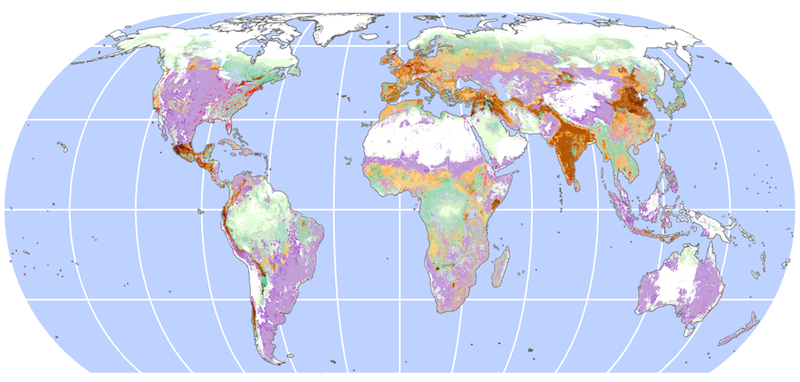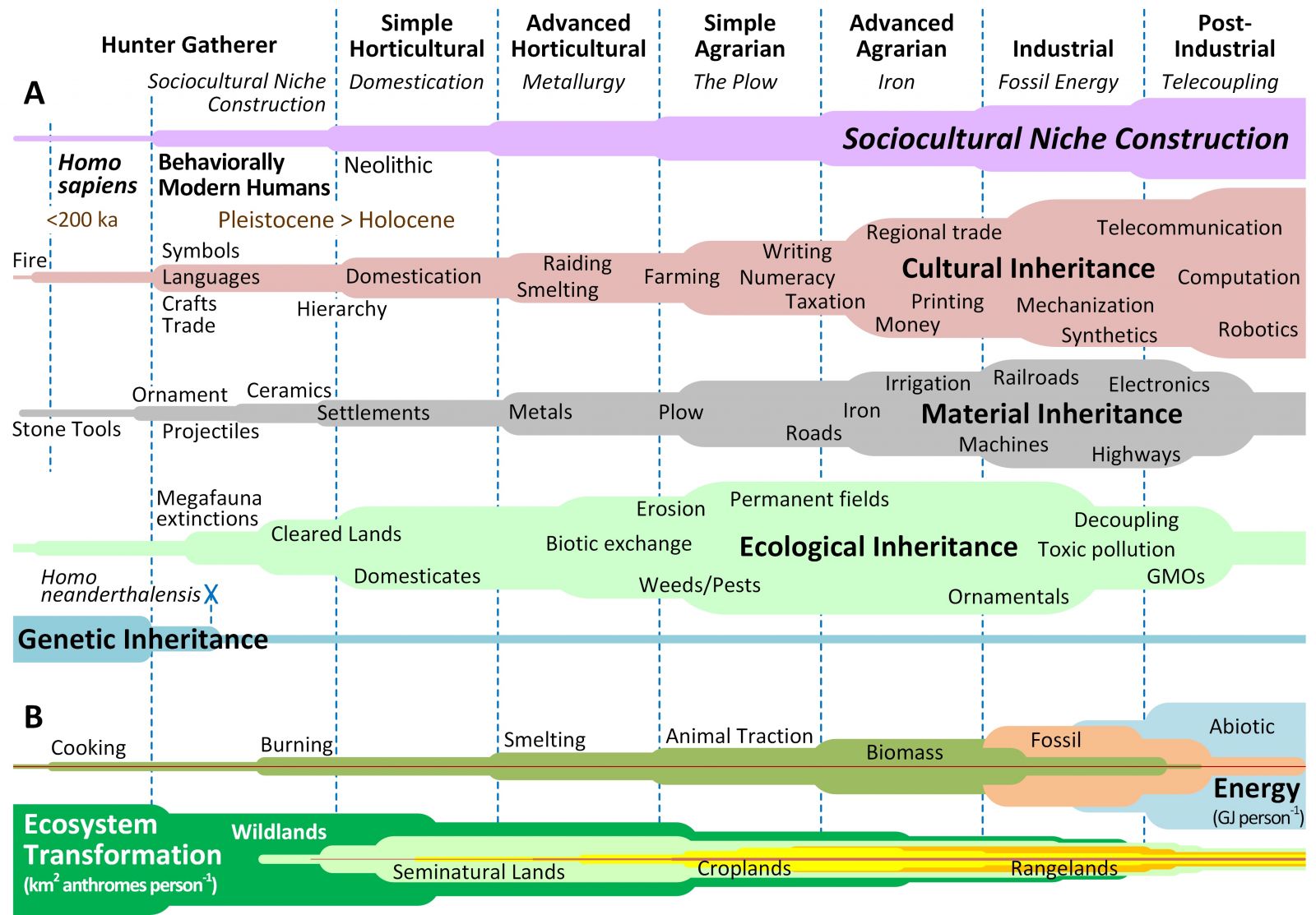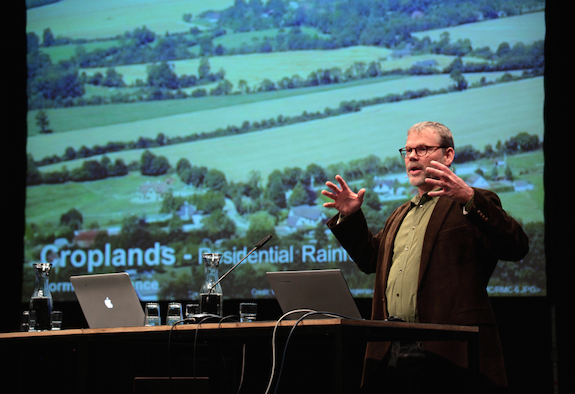Evolving toward a better Anthropocene
Erle Ellis is a professor of geography and environmental systems and director of the Laboratory of Anthropogenic Landscape Ecology at the University of Maryland, Baltimore County.
Humans have now transformed Earth to such a degree that a new epoch of geologic time, the Anthropocene, may soon mark the emergence of humanity as a “great force of nature.” The big question is why? Why did humans, and no other single multicellular species in the history of the Earth, gain the capacity to transform an entire planet? What is the nature of this new global force? Can we guide this force to create better outcomes for both people and nonhuman nature?
To answer these questions, we must go beyond geophysics, geochemistry and even biology. The principal cause of the Anthropocene is social, rooted in the exceptional capacities of Earth’s first ultrasocial species: behaviourally modern humans. Here I review a new transdisciplinary theory, called sociocultural niche construction, that explains why human societies gained the unprecedented capacity to transform an entire planet and how this relates to the challenges and opportunities of the Anthropocene.

Map showing when humans began to intensively use the land in various parts of the world, through heavy farming and other practices, dating from thousands of years ago (brown and orange) to just a few centuries or less (purple). Map: Erle Ellis
In prior work, I’ve focused on the ecological consequences of human actions, not the causes, such as in the rapidly-changing village landscapes across China. I’ve also worked globally to map “anthromes,” the ecological patterns that emerge when humans transform landscapes around the globe. But I always wanted to go deeper, to explain why humans so profoundly transform Earth’s ecology. One motivation was my envy of biogeography — where classic “natural” biomes are shaped by global patterns of climate. Tropical woodlands form under warm and moist conditions, for instance, and tundra appears in colder and drier regions. I wondered what are the analogous global forces of humanity that shape and sustain the anthromes? How do these forces of “human climate” reshape the biosphere over the long-term, from centuries to millennia? These questions require an approach fundamentally different from efforts to understand the day-to-day or even the year-to-year dynamics in social-ecological systems: the “human weather."
It took me years of intensive and extensive transdisciplinary learning — standing on the shoulders of giants (see references below) — to develop a theory explaining why human societies transform ecology over the long-term. I call it anthroecology theory.
A new evolutionary synthesis
At the core of this theory is sociocultural niche construction, a new evolutionary synthesis, which weaves together existing theories of niche construction, the Extended Evolutionary Synthesis, cultural evolution, ultrasociality and world systems theory. As implied by the name, sociocultural niche construction holds that the ecological niche of humans is social, cultural and constructed. Human societies have transformed Earth because their social capacities to construct the human ecological niche have scaled up and intensified through long-term processes of evolution by natural selection. To understand these changes, we begin with theory on niche construction and cultural evolution.
Classic ecological theory holds that species adapt to live within environmental constraints over which they have no control, such as heat or moisture. A species’ adaptations within these constraints form its ecological niche. Niche construction theory replaces this “one-way street” with the observation that many species, especially those known as “ecosystem engineers,” also alter their environments. That includes the building of dams (beavers) and nests (ants and many other animals) or the release of toxic chemicals that inhibit the growth of competitors (many microbes and plants like the creosote bush). When these environmental alterations affect a species’ ability to thrive, or the survival of other species sharing their environment, niche construction theory describes this as an ecological inheritance — a heritable consequence of environmental alteration with beneficial, detrimental or neutral consequences. In addition to ecological inheritances, many species also receive adaptive benefits when individuals learn behaviours from each other, such as the song dialects of birds and whales, which can be critical to reproductive success. These socially-learned adaptive behaviours are known as cultural inheritances.
The Extended Evolutionary Synthesis (EES), first called for in the 1980s by Stephen Jay Gould and formalised early this century by Massimo Pigliucci, Russell Bonduriansky, Étienne Danchin and others, melds cultural and ecological inheritances together with genetic, epigenetic and parental inheritances. This synthesis holds that these inheritances evolve together to produce evolutionary changes in the phenotype — the expressed traits of a species. The EES also incorporates the concept that inheritances can move not only “vertically,” as genetic traits pass from parents to progeny, but also “horizontally,” or among unrelated individuals within a single generation — as do genetic traits in microbes and cultural traits in birds or whales. Inheritance can also pass “obliquely,” or from older to younger generations.
The EES has huge implications for understanding the rise of cultural and ecological inheritances in the evolution of human societies and their transformation of ecology. When environments change rapidly, within the span of a single generation, the EES predicts that adaptive traits inherited horizontally, like cultural traits spread through social learning, can enable more rapid responses to environmental challenges than is possible through genetic adaptations, where the spread of adaptive traits takes generations. For this reason alone, cultural traits can be favored over genetic traits in rapidly changing environments.
Many species are social ecosystem engineers, including the social insects and naked mole rats. Yet behaviourally modern humans take sociality to the next level: ultrasociality. The capacity of behaviourally modern humans for social learning is unrivaled among species — even human sociality itself is socially learned. The very organisation of human societies is determined by culturally inherited traits, and human individuals commonly depend completely on relationships with non-kin individuals for survival.
In behaviourally modern human societies, sustenance and other necessities may be gained through complex social relationships among unrelated and even unknown individuals — by sharing, gifting, bartering, buying or just ordering online using a credit card. The need for foraging, farming or even shopping at the supermarket may be optional. The human ecological niche is thus largely sociocultural, constructed and enacted within, across and by individuals, social groups and societies based on socially learned behaviours. Long-term changes in the structure and functioning of human societies and their transformation of environments is the product of evolution by natural selection acting on these processes of sociocultural niche construction.
In the more than 50,000 years since behaviourally modern humans spread across the Earth out of Africa, human societies have evolved a tremendous diversity of complex cultural forms, all with profoundly different effects on their environments. This rapid diversification is partly explained by the observation — originally made by Darwin — that cultural traits can evolve far more rapidly than genetic traits. Human societies have often experienced runaway bursts of sociocultural niche construction, in which one change leads to such great social and environmental consequences that they must be adapted to by other, even more transformative changes in niche construction. As humans began to cultivate soils to grow crops, for instance, the fertility of soils dropped off. People compensated by harvesting and using manures to replace nutrients taken up or lost from the soil, a practice altering the entire social and ecological system of farming.
This runaway effect has marked human history: people began as hunter gatherers, using traps and projectiles and clearing vegetation with fire to enhance their ability to obtain food. Later peoples built on these cultural and ecological inheritances to form agricultural societies to produce even more transformative ecosystem engineering regimes. These included domesticating species, tilling and irrigating land and exchanging food and other needs and wants through barter and in early marketplaces. In doing so, agricultural societies grew larger and more complex with ever more specialised, diverse and unequal social organisation, from urban dwelling craftsmen to traders, artists and taxmen. These societies were reliant on ever more powerful and productive technologies for cooperative ecosystem engineering and the use of domestic livestock, wind and water power to supplement human energy.

As people built increasingly complex agricultural, then industrial, societies, and developed new ways of producing energy and transforming the land, human evolution was driven less by genetic inheritance and more by social factors like cultural inheritance and sociocultural niche construction. Graphic: Ellis 2015
Over more than 50,000 years of evolution in sociocultural niche construction, socially-learned strategies for cooperative ecosystem engineering have evolved from sustaining up to 10 hunter gatherers per square kilometer in a good year to sustaining more than 1,000 industrial citizens on the same area of land every year. As humans exploited new sources of energy, first from biomass and now mostly fossil fuels, per capita energy use has increased by more than an order of magnitude. Flows of material, energy, biota and information across human societies have become essentially global. Human lifespans today average nearly twice those of hunter gatherers and early farmers.
All of these trends have evolved through complex and convoluted trajectories in response to many different pressures, and different human societies continue to transform ecology in different ways. Nevertheless, the emergence of such a diversity of societal forms, and the rise of large-scale human societies capable of acting as a global force in the Earth system, is best explained as a process of evolution by natural selection acting on human sociocultural niche construction at the level of individuals, social groups and societies.
Are societies evolving towards a better Future Earth?
In recognising the Anthropocene as a new epoch of geologic time, we are confronted with the reality that our societies now directly shape Earth’s functioning. For better and for worse, our planet now changes with us, not apart from us. While for most people times may never have been better, the opposite is true for most other species. There are also strong indications that anthropogenic global changes in climate and biodiversity might derail future prospects for societal development. For example, the costs of climate change adaptation and the loss of wild pollinators might be unbearable burdens for some societies. We shouldn’t forget that evolutionary processes produce both adaptations and extinctions. Even the most successful large-scale societies will not last forever.
The processes that enable societies to adapt and to thrive in the face of long-term social and environmental challenges are not fully understood — a prime area for greater research investment. However, existing archaeological evidence suggests that societal capacity to anticipate, sense, interpret and respond to both external and internal challenges through adaptive processes of social change is essential to societal resilience. Some societies readily adapt to massive environmental challenges that overwhelm the adaptive capacities of others; some build irrigation systems, while others collapse. The archaeological record has repeatedly falsified the hypothesis that hard environmental limits, such as climate, alone determine the fate of human societies. The capacity of societies to thrive sustainably is a social capacity.
Behaviourally modern human societies have always engineered ecosystems to sustain themselves. Human societies are not sustained by the “balance of nature” but by a sociocultural niche constructed through cooperative ecosystem engineering and the social exchange of food and other needs and wants. Hunger is not caused by environmental limits to food production but by social limits to food distribution. That is why today, despite adequate food production, some still remain unfed.

Erle Ellis during a recent talk on the Anthropocene. Photo: Erle Ellis
For these reasons, we must focus on the social and cultural capacities of society to understand and address the societal challenges of the Anthropocene. Humans are a sociocultural species living in a sociocultural world on a used planet. “Getting back to nature” is not going to help. The focus must be on building strategies to shape nature more beneficially for both humans and nonhumans. Yet it remains to be seen whether societal efforts to intervene in the human climate system can generate better long-term outcomes for humanity and nonhuman nature.
The accelerating resource demands of increasingly wealthy urban populations are driving potentially disastrous changes in the Earth system from global climate change to mass extinctions and other unprecedented environmental changes. Yet these same global trends have brought benefits, too: we are using land more efficiently to produce food, and our energy systems now rely less on combusting biomass. We have even begun the process of replacing fossil fuels with more sustainable energies. Moreover, global communications have led to an acceleration in social learning, knowledge sharing and other interactions, potentially generating new solutions for global problems. Urbanisation and societal upscaling in general — the economies of scale — offer real planetary opportunities to spare more of the biosphere for nonhuman species while improving quality of life for humans.
Humans have always been far more than “destroyers of nature.” Human societies have reduced and eliminated pollution, have protected and restored endangered species and their habitats and may even now be undergoing a massive shift in energy systems that could prevent catastrophic global climate change. The boom in Anthropocene discussions might itself indicate that societies are waking up to the realities of becoming a global force in the Earth system.
Without intending to, human societies evolved the capacity to force Earth into the Anthropocene. Sociocultural strategies for avoiding the worst consequences of anthropogenic climate change, mass extinction and social inequality might already be evolving. Or perhaps, societies will just adapt to living in more and more unequal societies on a hotter, less biodiverse planet. Either future is plausible, as are others. But it should be clear — to everyone — which future is better.
Human societies and their cultures of nature will shape the future of life on Earth for the foreseeable future. By engaging with, not against, the processes of sociocultural niche construction, we might guide this new “great force of nature” toward better outcomes for both humanity and nonhuman nature. It is time to embrace what makes us human, ultrasociality, and turn it towards the grand challenges of the Anthropocene -– to intentionally build better societies and cultures of nature.
References
Boserup, E. (1981) Population and Technological Change: A Study of Long Term Trends. University of Chicago Press.
Buchan, N. R., G. Grimalda, R. Wilson, M. Brewer, E. Fatas and M. Foddy. 2009. Globalization and human cooperation. Proceedings of the National Academy of Sciences 106:4138-4142.
Butzer, K.W. (1982) Archaeology as Human Ecology: Method and Theory for a Contextual Approach. Cambridge University Press.
Butzer, K. W. and G. H. Endfield. 2012. Critical perspectives on historical collapse. Proceedings of the National Academy of Sciences 109:3628-3631.
Chase-Dunn, C.K., Lerro, B. (2013) Social Change: Globalization from the Stone Age to the Present. Paradigm Publishers.
Danchin, É. 2013. Avatars of information: towards an inclusive evolutionary synthesis. Trends in Ecology & Evolution 28:351-358.
Danchin, É., A. Charmantier, F. A. Champagne, A. Mesoudi, B. Pujol and S. Blanchet. 2011. Beyond DNA: integrating inclusive inheritance into an extended theory of evolution. Nature Reviews Genetics 12:475-486.
Ellis, E.C. 2015. Ecology in an anthropogenic biosphere. Ecological Monographs 85: 287-331.
Henrich, J. 2015. The Secret of Our Success: How Culture Is Driving Human Evolution, Domesticating Our Species, and Making Us Smarter. Princeton University Press.
Laland, K. N., J. Odling-Smee and M. W. Feldman. 2000. Niche construction, biological evolution, and cultural change. Behavioral and Brain Sciences 23:131-146.
Mesoudi, A. 2016. Cultural evolution: integrating psychology, evolution and culture. Current Opinion in Psychology 7:17-22.
Odling-Smee, F. J., K. N. Laland and M. W. Feldman. 2003. Niche Construction: The Neglected Process in Evolution. Princeton University Press.
Smith, B. D. 2007. The ultimate ecosystem engineers. Science 315:1797-1798.
Steffen, W., P. J. Crutzen and J. R. McNeill. 2007. The Anthropocene: Are Humans Now Overwhelming the Great Forces of Nature. AMBIO: A Journal of the Human Environment 36:614-621.
Waring, T. M., M. A. Kline, J. S. Brooks, S. H. Goff, J. Gowdy, M. A. Janssen, P. E. Smaldino and J. Jacquet. 2015. A multilevel evolutionary framework for sustainability analysis. Ecology and Society 20:34.
Wilson, D. S., S. C. Hayes, A. Biglan and D. D. Embry. 2014. Evolving the future: Toward a science of intentional change. Behavioral and Brain Sciences 37:395-416.
DATE
March 29, 2016AUTHOR
Erle EllisSHARE WITH YOUR NETWORK
RELATED POSTS
Spotlight on LMICs – Tired of Breathing in Pollutants? Time for Better Fuel Economy and Vehicle Standards
Future Earth Taipei Holds 2024 Annual Symposium
Spotlight on LMICs – The Future’s Juggernaut: Positioning Research as Anchors for Environmental Health